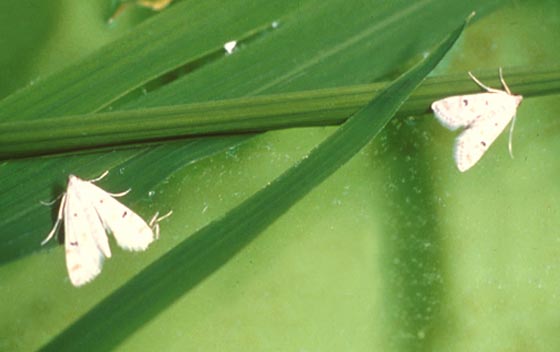Rice caseworm
Nymphula depunctalis (Guenee)
What it does
 Rice caseworms or case bearers cut off leaf tips to make leaf cases. Their feeding damage can cut leaves at right angles as with a pair of scissors.
Rice caseworms or case bearers cut off leaf tips to make leaf cases. Their feeding damage can cut leaves at right angles as with a pair of scissors.
Why and where it occurs
The insect is most likely to be found in rice fields with standing water, in both wetland and irrigated environments. Transplanting young seedlings also favors the development of the insect.
The insect is commonly found in rice fields in low populations.
The adults are nocturnal and are attracted to light traps. The larva hides in its case then float on the water surface during the day and crawls to the rice plant with its case to feed.
Severe infestation may be observed occasionally on dwarf, compact, heavy tillering, and high yielding varieties during the rainy season.
How to identify
To identify caseworm damage, check for:
- Leaf cases floating on water
- Leaves cut at right angles as with a pair of scissors
- Leaves with papery upper epidermis that were fed on
- Skeletonized leaf tissues usually appear ladder-like
Damage symptoms can be confused with other defoliating insect pests. To confirm caseworm, visually inspect for appearance of the ladder-like leaf tissues, cut leaves, and leaf cases attached onto leaf sheaths and floating in the water with the larvae enclosed.
Why is it important
The rice caseworm is commonly found in rice fields in low populations. It can build up and cause patches of severe defoliation that results in stunted growth and death of plants because of pesticide use, control practices, and ecological disruptions by weather.
The rice plants can recover from the damage if there are no other defoliators present. However, maturity may be delayed for 7−10 days.
How to manage
- Use of correct fertilizer application.
- Plant early and use wider spacing (30 × 20 cm).
- Drain the field.
- Transplant older seedlings. Sparse planting can also reduce the damage.
- Grow a ratoon.
- Encourage biological control agents: snails (feed on eggs), hydrophilid and dytiscid water beetles (feed on larvae), spiders, dragonflies, and birds (feed on adults), nuclear polyhedrosis virus (a potential control agent)
- Use foliar treatments of carbamate insecticides; avoid pyrethroids.







